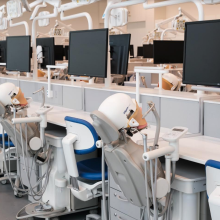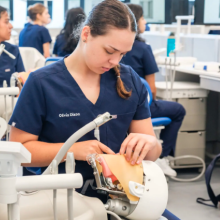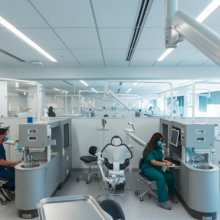What makes the CWRU School of Dental Medicine different?
CWRU-educated dentists have a head start on their peers who graduate from other dental schools. Our graduates are more experienced, more skilled, and more confident as a benefit of our learning culture that integrates classroom, clinic, research and community.
The School of Dental Medicine's Doctor of Dental Medicine program provides students the opportunity to become successful people and dentists who make a positive difference in the health and well-being of the people and communities they serve. The full-time four-year DMD degree program's competency-based curriculum involves integrated systems-based biomedical sciences, preclinical and clinical dental sciences, preclinical simulation, comprehensive patient care, interprofessional collaborative practice, behavioral sciences, ethics and professionalism, practice management, research opportunities and community service. Students are taught and mentored by skilled and experienced faculty in a humanistic environment that emphasizes professionalism, personal and professional responsibility, mutual respect, teamwork, critical-thinking skills and extensive hands-on preclinical and clinical general dentistry experiences, requirements and competencies. Graduates are well prepared for licensure and to pursue general dental practice as well as advanced education residency programs. As lifelong learners, graduates must continue their dental education throughout their professional careers in order to stay current in their field, make decisions based on scientific evidence and deliver high quality patient-centered care. While in dental school, students grow as ethical professionals with a commitment to and responsibility for their patient's best interests and welfare, to provide patients with optimal dental care.
The REAL Curriculum
REAL stands for Relevant Experiential Active Learning. Key features of our award-winning curriculum are:
- A small-group learning environment where students share responsibility for learning;
- Time for self-directed inquiry, integration of concepts and reflection about learning;
- A commitment to creating a culture of evidence-based scholarship;
- Cornerstone experiences that integrate multiple content areas in intense, powerful learning scenarios within the school and the community;
- Realistic patient simulation to develop clinical skills in restorative dentistry, prosthodontics, endodontics, periodontics, pediatric dentistry and implant dentistry to prepare students for successful transition into delivering patient care in the School's dental clinics.
- Development of clinical skills in an environment similar to a small-group practice.
REAL Curriculum: Classroom
Simulator-facilitated learning for each first-year and second-year student
Our simulation clinics are among the most advanced in the world. The School of Dental Medicine’s state-of-the-art Simulation Clinic, equipped with the latest in dental technology, equipment and instruments, including A-dec dental patient simulators with programmable touchpads, operating lights and operator stools that will match how student doctors will perform patient care with A-dec dental units in the clinic; Kilgore dental manikins and typodonts; a $350,000 in-kind donation of Bien-Air Optima MX2 electric motor systems; Computer screens at each simulator station for multimedia learning; simulation clinic space for CADCAM scan, design, milling as well as 3D printing; and a separate 10 seat simulation space with Sim-Ex augmented reality dental simulators, where dental students will practice 3D real time visualization, feedback and self-assessment of their high speed handpiece skills in performing operative dentistry and fixed prosthodontics procedures.
The Simulation Clinic enhances students’ learning experiences by providing them with the most realistic patient simulation to develop clinical skills in restorative dentistry, prosthodontics, endodontics, periodontics, pediatric dentistry and implant dentistry to prepare students for successful transition into delivering patient care in the School's Dental Clinics. In the HEC Digital Suite, Case Western Reserve University dental students are the first dental students in the US to learn HoloAnatomy and HoloNeuro 3D mixed reality human anatomy, from a $91,000 School of Dental Medicine investment in HoloLens visors and HoloAnatomy software.
As the School of Dental Medicine continues to invest in cutting-edge facilities and technology, it solidifies its reputation as a leader in dental education, dedicated to preparing students for the future of dentistry.
Improving the classroom experience
At the end of each semester, students complete course evaluations to give feedback to the course directors and the Committee on Dental Education (whose membership includes two students). The Associate Dean for Academic Affairs elicits student feedback at the end of each academic year, and the Dean, Associate Dean for Clinical Affairs and Associate Dean for Academic Affairs meets monthly with class representatives to identify issues that need to be addressed. Finally, fourth-year students complete an exit survey prior to graduation whose feedback is considered by the Committee on Dental Education.
REAL Curriculum: Clinic
The clinical patient care component of the School of Dental Medicine prepares practice-ready graduates for the practice of general dentistry as dental students achieve the competence required to diagnose conditions, develop treatment plans, manage and treat patients. Students initially develop basic knowledge and skills with faculty assistance, and ultimately develop sound clinical judgment, good interpersonal relations and communication skills, efficient management of time and resources, and the technical confidence proficiency to complete Clinical Competencies for independent practice of dentistry. By the time of graduation, students are capable of providing oral health care to patients with independence, initiative, confidence, compassion and competence.
The 132,000 square-foot Dental Clinic located directly across from the Samson Pavilion features 225 state-of-the-art patient care facilities, equipped with the latest equipment and digital technology, including a Yomi robotic implant surgery unit and an Ambulatory Surgery Center with 2 hospital size operating rooms and postoperative recovery facility. Four levels high, the Dental Clinics were designed with security, efficiency and patient safety as priorities. The lower level includes a cutting-edge Steris sterilization center, the student lounge, lockers and mailboxes and the School’s Information Technology team.
The first floor level is home to the Oral and Maxillofacial Surgery Department, the Advanced Education in General Dentistry program, the Faculty Practice and the Ambulatory Surgery Center. The entire Dental Clinics are supported by the Oral and Maxillofacial Radiology clinic that operates digitally with two CBCT machines and a digital panoramic/cephalogram machine. The Departments of Orthodontics, including the Craniofacial and Special Care Orthodontics Fellowship program, Pediatric Dentistry, Endodontics, Periodontics and Oral and Maxillofacial Medicine and Diagnostic Sciences including the Patient Admitting clinic are located on the second level of the Dental Clinic. The pre-doctoral DMD Clinics contain eight practice groups with 15 chairs in each group. Each of the eight groups have approximately 19 D3 and D4 students assigned to that space, and each group is covered by two faculty preceptors. Faculty preceptors are also supported by 11 full time faculty members in Comprehensive Care who rotate through the clinic as scheduled. On each floor, the reception area has scheduling agents who assist patients with registration as well as checking them in and out of the clinic. Scheduling agents work with students and patients as a dental practice would, to manage patient schedules efficiently.
Drawing from a local population of more than one million and regional population of 3.6 million, the dental clinics provide a broad spectrum of care to the population, affording the student substantial clinical experience. The school cooperates with various organizations of the city in caring for their patients and clients, an arrangement that provides additional clinical experience for students. The School of Dental Medicine has working relationships with hospitals and health clinics in the Greater Cleveland community, including the Cleveland Clinic Foundation, MetroHealth, University Hospitals and the Louis Stokes Cleveland VA Medical Center, where students have opportunities to function as dentists and observe hospital routine and operating room techniques in these hospitals. Many members of the faculty hold staff appointments in these extramural health facilities.
Bridge to Independence
Third- and fourth-year students are assigned to a practice group with around 16 other students, much like a small group practice. Each group has two faculty preceptors who help each student as mentors or senior partners to develop treatment plans for each patient and oversee the quality of work performed. The preceptors cooperate with full-time faculty members to assess each student's technical and professional skills.
Practice Management Experience
Each preceptor group also has a patient care coordinator (PCC), who acts as an office manager in a typical private practice. The PCC helps each student to make appointments with patients, control recalls, manage insurance forms, and enter treatment plans so that he/she can attend to the care of each assigned patient. In this way, students develop an appreciation for the collegial, managerial and entrepreneurial aspects of dentistry. In fact, every fourth-year student is expected to develop a business plan for a hypothetical practice that will be critiqued and perfected under the guidance of accountants and other practicing dentists.
REAL Curriculum: Research
Culture of Inquiry and Professionalism
Our students begin to think like health care professionals through our small-group problem-based discussion sessions, which serve to complement didactic lectures. Guided by facilitators, these sessions are similar to discussions that can occur during rounds or laboratory meetings. Each student begins to learn about the resources dentists and health care professionals use to better serve each patient in making differential diagnoses and developing treatment plans. By integrating the knowledge of the biomedical sciences, clinical dental sciences, pharmacology, psychology, sociology and ethical and professional considerations behind each simulated patient, students learn how to think, interact, communicate, and pursue knowledge as leaders in health care delivery.
Research Reveals the Future of Dentistry and Preventive Care
Many students directly participate in projects conducted by our world-class faculty at the School of Dental Medicine and present their findings at the annual Professionals Day each spring. Often they are rewarded with authorships and invited presentations at international meetings along with their faculty mentors.
Our students have assisted in the discovery of antibiotics that are naturally produced in the mouth that could combat HIV replication, signal progression of cancer, or predict difficulties in cardiovascular disease or pre-term birth. Students also assist with health disparities faculty research projects that focus on preventing childhood cavities (caries) in underserved, high-risk populations and establish research networks among dental practices to more rapidly evaluate and communicate evidence-based findings in routine patient care. Finally, our research collaborations with the University's other schools further push the edge of innovation to develop better materials for dentistry or to better address factors that affect disparities in health care quality.
The School of Dental Medicine also offers students the option to pursue a Master's Degree in Clinical Research Training with the School of Medicine that allows students to focus their talents to conduct clinical and translational research on oral health problems and disparities. Usually students participate in this master's year between their traditional second and third years of dental education in order to complete a thesis and present their work in a national conference.
REAL Curriculum: Community
Healthy Smiles Sealant Program
As the first Cornerstone Experience in our curriculum, Healthy Smiles is a win-win situation. Kids at risk for a lifetime of tooth problems get a good start on better dental health, and students get a head start on professional training.
First-year students participate in our award-winning Healthy Smiles Sealant Program by introducing them to second-, third-, and sixth-grade students attending Cleveland-area schools to perform dental exams and place sealants on their teeth. Students are prepared through the Outreach Preventative Dentistry course, developed specifically for the sealant program. It's an intense overview of beginning dentistry that lasts until Thanksgiving break and includes everything the students need to know to participate in the sealant program, such as taking a patient's health history, assembling portable dental chairs, and using all the tools in the accompanying kits.
International and Interprofessional Learning and Collaboration
The new Health Education Campus—comprising the Sheila and Eric Samson Pavilion and dental clinic building—is envisioned as a way to foster collaboration and communication among future health care professionals from all fields, including medicine, nursing, dental medicine, physician assistant and social work. Students participate in interprofessional education experiences throughout their first year, in the Collaborative Practice I curriculum.
The School of Dental Medicine also participates in giving critical oral health services via mission trips to underserved areas, such as Peru and the Dominican Republic. These programs are additional elective opportunities for our students to understand the difficulties and challenges of global health care delivery.




